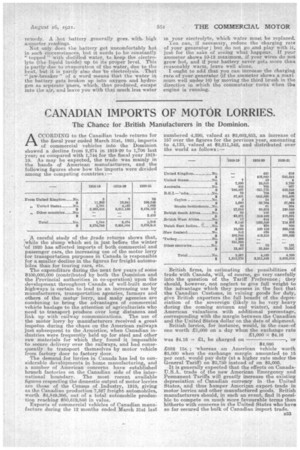FORD VAN POINTERS.
Page 28

Page 29

If you've noticed an error in this article please click here to report it so we can fix it.
By R. T. Nicholson (Author of "The Book of the Ford ").
IHAPPENED across en odd case the other day. Talking with a Ford van driver, I learnt that he had had the best of satisfaction out of his vehicle, except that the wire between his cut-out and ammeter was always fusing. He wanted to
know what he ought to de about it. ,
378.—The Wire That Fused.
It seemed'that, so far, he had merely replaced the wire from time to time, when it fused, carrying a length of insulated wire with that possibility in view. I cross-examined him about his ammeter readings, and he told me that at any decent speed he got a reading of 12, and that the reading at high speeds was well in excess of that. I diagnosed this as a case of an over-powerful generator. ,I have come across very few such cases, but I know that they eceine Of course, I may have been wrong in my diagnosis (for I could not go fully into things at the time). If the wire in use between cut-out and generator was too small,. that would account for the fusing. I am pretty sure, however, thatthis was not the case. The ammeter readings gave the clue. The maximum reading at any engine speed whatever (however great) should not exceed a steady 12. . (An occasional road bump may, of course, throw it momentarily higher, but road bumps do not count.) The reading is, in fact, better nearer 10 than 12, unless a great deal of-use is made of the starter and the lights, but 12 should, at all events, be the outside maximum steady reading. This means that the generator is delivering at most 12 amperes; and.if the generator regularly delivers more than 12 amperes, it is probably straining the wire in question—straining it electrically. Substitution of a thicker wire would prevent this strain ; but that would not really cure thetrouble, because the strain would only be transferred to other wiring, and, finally, to the battery, which would get over:charged."
379.—Reducing Generator Output.
The remedy is to lower the generator' output, so that the ammeter reading is somewhere between 10 and 12. This an be done by alteration of the position of the third brush in relation to the generator 032 commutator. There are three-brushes in the generator—two fixed, one adjustable. The adjustable brush is a bit smaller than the other two. When you take off the domed cover at the back end of the generator—a matter, of removing two round-headed screws--you can see through roomy slots into the inside of the generator; looking right down on the commutator. Look through the slot that lies to' the right of the generator terminal when you stand facing the back of the generator, and you will see that rthird brush. It lies in a movable holder. To decrease the charging rate, you want to bring that brush holder farther round in the direction opposite to that in which the commutator turns when the engine is running. (Better get a friend to turn the starting handle slowly while you look through the' slots to make sure.) Before you can move it in that direction, you must loosen the nut on the bolt which holds the third brush holder in place. To loosen this nut, yen want a thin, open-ended; fixed spanner which will fit it. Only loosen slightly—not nearly enough to turn the nut off the bolt, or you will have a job to recover it. When the nut is loose, you can tap the brush holder in the right direction. Then tighten up the nut again. Only move the brush holder slightly, or you may reduce the amperage too much. You can easily move it a bit farther later on, if the ammeter readings still show too high. If you find that your battery gets uncomfortably hot to the touch after, say, 20 miles' unbroken rim, suspect that the generator is 'too powerful. The battery ought to get only comfortably warm. Adjusting the position of the third brush, as above, is the remedy. A :hot battery ,generally goes, with :high ammeter readings.
Not only does the battery get uncomfortably hot in such circumstances, bid it needs to be constantly " topped " with distilled water, to keep the electrolyte the liquid inside) up to its proper level. This is partly due to evaporation of the water, due to the heat, but it is partly also due to electrolysis.That " jaw-breaker " of a word means that the water in the battery gets broken up into oxygen and hydrogen as separate -gaseS, whiek, thus produced, escape into the air, and leave you with that much less water
in your electrolyte, which water must be replaced.
You can, if necessary, reduce the charging rate of your generator ; but .do not go and play with it, just for the sake of -seeing what happens. If your ammeter shows 10-12 maximum, if your wires do not grow hot, and if your battery never gets more than
reasonably warm, leave well alone. , I ought to add that you can• increase the charging rate of your. generator(if -the ammeter shows a maximum well under 10) by moving the third brush in the direction in which the commutator turns when the engine is running.
































